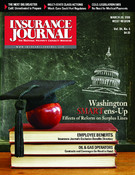The proper allocation and remittance of surplus lines premium taxes to the states on multi-state risks has been the most vexing problem faced by surplus lines brokers during the nearly 116-year history of the industry. In recent years, the multi-state tax allocation and remittance problems faced by surplus lines brokers have been compounded by the proliferation of nonresident surplus lines broker licenses generated by the passage of the Gramm-Leach-Bliley Act (GLB)just a few years ago.
For decades, the National Association of Professional Surplus Lines Offices’ broker membership has been concerned with the problem. It was and continues to be, without question, the most serious and vexing problem facing the surplus broker in transacting surplus lines business. The failure of the states to establish a uniform and consistent method of remitting surplus lines premium taxes on multi-state surplus lines risks also has diminished the market’s usefulness to both consumers and producers.
In the past 15 years, NAPSLO has been involved in at least five different initiatives with the National Association of Insurance Commissioners and other organizations to solve the problem. Unfortunately, all of those efforts have failed. Today, the problem continues and has become more severe, as a greater percentage of surplus lines placements are now multi-state risks.
The problems with the remittance of premium tax to the states on multi-state surplus lines risks tax is found in the conflicting and inconsistent state tax and regulatory laws. At a minimum, the lack of harmonization in state laws makes multi-state surplus lines transactions complicated and confusing, and adds unnecessary costs to the transaction. At their worst, the inconsistencies actually frustrate the transaction to the detriment of consumers and brokers.
While the problem is complex, the inconsistencies and conflicts are focused in two areas. First, there is no universally accepted allocation formula among states. Consequently, the broker must determine which state’s allocation formula, in a multi-state surplus lines risk, governs the transaction. Second, the taxing provision of each state’s surplus lines laws is directed to the licensed surplus lines broker placing the coverage and requires that tax on the portion of the premium allocated to the state be paid to that state. There is no mandate in state laws that the broker remit a tax on portions of the premium allocated to other states. Thus, there is no legal basis, much less a legal mechanism, for the broker to remit the premium tax to another state, particularly to a state in which the broker is not licensed.
The enactment of GLB and the creation of surplus lines non-resident licenses were promoted as a solution to the latter problem by providing a mechanism for the nonresident broker to remit the premium tax. Unfortunately, GLB and nonresident licensing, while providing a legal method to remit the tax, has not solved the problem completely and has created a host of additional difficulties for surplus lines brokers.
As surplus lines brokers acquire nonresident surplus lines licenses, they find that state laws provide no guidance on which state surplus lines law governs a multi-state surplus transaction. Without a universal allocation formula as to how to allocate the premium and without direction as to which state law actually controls the allocation, confusion and misunderstanding prevail on how much premium tax is owed, and to which states it is owed.
Moreover, for a surplus lines brokerage to deal in multi-state risks (which is a must), it would have to obtain and maintain more than 100 licenses — 50 or more general agent or broker licenses, 50 or more surplus lines licenses and some additional corporate licenses as required by some states. To the extent that GLB solved the surplus lines tax remittance problem … it is a cure that is worse than the disease.
However, the worst problem that GLB and nonresident licensing foisted on surplus lines brokers is the requirement of multiple state compliance on multi-state risks. As surplus lines brokers acquire nonresident surplus lines licenses, often just to pay taxes, they find that without guidance on which state law governs a multi-state surplus lines placement, they are faced with full compliance with surplus lines laws in every state in which an exposure exists. That means multiple diligent searches (under different standards), multiple regulatory filings and affidavits, multiple tax filings, multiple surplus lines information notices on the declarations page or policy, and other multiple regulatory requirements. Those multiple regulatory requirements hold the potential for strangling the surplus lines business.
To address those issues, NAPSLO recently published a white paper titled, “Regulation of the Surplus Lines Industry after Gramm Leach Bliley: The Future is Now.” The white paper examines the issue and offers solutions. The white paper sets forth the concept of a clearinghouse through the creation of an interstate compact to act as the structure and coordinating entity for the collection and allocation of the surplus lines premium tax, and in the oversight of compliance in multi-state surplus lines transactions.
The problems facing surplus lines brokers in premium tax allocation and remittance, as well as multiple state compliance on multi-state risks, are difficult. But if the industry is to go forward and serve the public, those problems must be overcome soon. NAPSLO will continue to offer solutions and provide leadership in finding a permanent solution.
Richard Bouhan is the executive director of NAPSLO.
Topics Agencies Legislation Excess Surplus
Was this article valuable?
Here are more articles you may enjoy.


 Kansas Man Sentenced to Probation for Insurance Fraud
Kansas Man Sentenced to Probation for Insurance Fraud  Howden Buys M&A Insurance Broker Atlantic Group in US Expansion
Howden Buys M&A Insurance Broker Atlantic Group in US Expansion  High-Net-Worth Risk Appetite Drops as Some Regions Show Stabilization
High-Net-Worth Risk Appetite Drops as Some Regions Show Stabilization  Litigation Funding, Other New Laws in SE States Could Impact Liability Insurance
Litigation Funding, Other New Laws in SE States Could Impact Liability Insurance 


